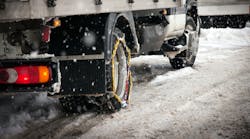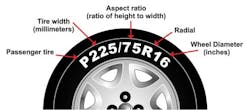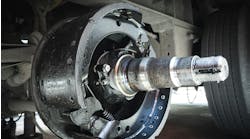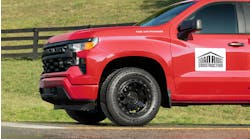Snow chains are some of the most valuable, yet under-discussed, cold weather accessories for heavy-duty commercial vehicles. Certain U.S. states require truck drivers to carry them on their heavy-duty vehicles during the frigid months of the year, and they are recommended for driver safety and vehicle protection. In this article, we will discuss the basics of snow chains including what truckers need to know about chain laws and proper installation.
What are snow chains?
As the name implies, snow chains, also known as tire chains, are typically made from steel, polyurethane, and rubber to form links that wrap around tires that provide maximum traction on slippery surfaces such as snow and ice. The traction is in thanks to the chains grabbing onto the winter elements. When this happens, friction is created between the tires and the ground—preventing sudden sliding of the vehicle—and thus, keeping drivers more in control. Using snow chains should be avoided on bare pavement or plowed roads as the dry surfaces could damage the roads, the chains, and tires.
How many snow chains will I need?
Generally, only one set of snow chains is needed on any semi-trailer, regardless of the number of axles, to meet most state and local requirements; however, trucks in California may need up to eight chains in the wintertime to comply with their requirements (but we’ll get into snow chain state laws shortly). Trailers with brakes will need snow chains on braking axles while front wheel drive vehicles will need them on the front (drive) axles. Tag axles do not require chains.
Snow chain laws
Chain laws vary by state and so do the penalties for failing to comply. During inclement weather, and at high elevations, Colorado may require truckers to have snow chains from September 1 through May 31. Since the state has two levels of chain laws, it is best to understand both types and act accordingly. Failing to have chains on trucks when the Colorado law is in effect may result in a $500 fine plus a $79 surcharge fee or $1,000 plus a $157 surcharge if you are blocking the highway. California does not require trucks to carry chains during a specific time; however, the laws go into effect when highway signage is posted. Pennsylvania truckers can use “tire chains on two tires on a driven axle” when there is a declared state of emergency, and commercial vehicles in Georgia must have chains on the outermost drive tires during severe weather.
Installing snow chains
Because snow chain laws are volatile, snow chain installation is quick and easy—only taking about 10 minutes. There are several methods for hanging chains on tires, but the easiest way is to first lay the chains out flat on the ground. Then, pick up the chains and spread them evenly over the tire surface—center aligning as best you can. If you have excess chains in the front, simply tuck them underneath the tire so when you move the vehicle forward it won’t affect the back part of the chain. When you are satisfied with placement, tug the ends of the chains together and hook the inside clip between the tires. Apply the same method with the cross chains and tighten them with the side chain fastener to complete installation.
Know this before buying chains
Snow chains will last for several years with proper care; but when you are ready for replacement, you will need to be able to “read” your tires to buy the appropriate chains. Peerless Chain Company, a manufacturer of snow chains in the U.S., shares a great graphic on their website that can help drivers evaluate their tire size. Drivers may need to know the tire width, aspect ratio, and radial and wheel diameter to get started.It’s snow chain season
Truckers are expected to make it to their final destinations promptly regardless of inclement weather. Driving in the snow is stressful for any kind of driver, but with the help from snow chains, truck drivers can feel at ease that they will get to their destination safely and on time.
Jennifer Smith is an e-Commerce Digital Content Specialist at JIT Truck Parts in Highland Park, Illinois.





